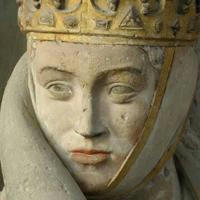
The Exaltation of Beauty
European art and culture. @Revolt888 @WrathOfGnon77 @OrthodoxSpirituality555
إظهار المزيد6 065
المشتركون
+924 ساعات
+727 أيام
+20930 أيام
- المشتركون
- التغطية البريدية
- ER - نسبة المشاركة
جاري تحميل البيانات...
معدل نمو المشترك
جاري تحميل البيانات...
Corporations of the Dutch Republic commemorated their histories with representations of significant past events. In 1654, the water management board of Leiden, for example, commissioned Caesar van Everdingen to paint the granting of its charter by the Count of Holland in 1255. By clothing the Count in seventeenth-century royal dress and setting the event in a classicizing space that evoked the latest style in public architecture, van Everdingen underscored the theme's relevance to water control in his own day.
Count_William_II_grants_the_charter_to_the_Water_Board_of_Rhineland.jpg6.62 MB
Photo unavailableShow in Telegram
Count Willem II of Holland Granting Privileges, 1655, by Caesar van Everdingen, oil on canvas, 218 x 212 cm, Gemeenlandshuis, Leiden
This painting and its pendant (Bust of Adonis, Museum, Cape Town) are the only still-lifes Van Everdingen painted. For a classicist like this painter still-lifes were a second-rate genre. These two paintings are most unusual still-lifes and, at the same time, figure pieces.
In this painting the woman is a cast of the upper section of the Venus Medici, a full-length sculpture of a nude. It was at the Villa Medici in Rome until 1677 when it was transferred to the Uffizi in Florence. It is a copy after a Greek original dating from the late classical era. The child beside the bust is Cupid, the son of Venus.
600066slsdl.jpg2.10 MB
Photo unavailableShow in Telegram
Still-Life with a Bust of Venus, 1665, by Caesar van Everdingen, oil on canvas, 74 x 61 cm, Mauritshuis, The Hague
At the time, the parable was cited in numerous tracts on education. In Everdingen's painting the scene is crystal clear and every detail is rendered with meticulous precision. And yet there is something unreal about it. It begs comparison with a 'tableau vivant' or a set of wax statues.
Lycurgus Demonstrates the Benefits of Education.jpg1.90 MB
Photo unavailableShow in Telegram
Lycurgus Demonstrates the Benefits of Education, 1660-62, by Caesar van Everdingen, oil on canvas, 167 x 219 cm, Stedelijk Museum, Alkmaar
The painting illustrates an anecdote by Plutarch about the Spartan king Lycurgus. Seated in the market place, the king addressed the crowd assembled around him on the importance of a proper upbringing. He called his two dogs to demonstrate his point and placed before them a bowl of food and a live hare. One chased after the hare, but the other stopped to eat from the bowl. Lycurgus then explained to the mystified onlookers: 'These two dogs came from the same litter but they were raised in different ways. One has turned into glutton and the other a spirited hunting dog.' Lycurgus had trained one for the hunt and allowed the other to go its own way. The latter is the animal licking the pot in the foreground, while the hunting dog stands beside Lycurgus and receives an approving pat on the head. The hare it has caught lies on the step at Lycurgus' feet.
The nymph Syrinx is on the run, with the forest god Pan, hidden among the dense vegetation, in hot pursuit. Van Everdingen captures the dramatic moment of the metamorphosis as Syrinx implores the river nymphs for help. They transform her into water reeds. Her right foot is already turning green. Disappointed, Pan listens to the wind playing through the tall reeds and subsequently cuts his flute from them.
400098mtsdl.jpg8.44 MB
Photo unavailableShow in Telegram
Pan and Syrinx, by Caesar van Everdingen, c. 1637 - c. 1640, oil on panel, 49.5cm × 37cm, Rijkmuseum
The refined, generalized forms, clear outlines, and sensitivity to the effects of light of his Four Muses with Pegasus shows what sets him apart. Everdingen acquired his interest in representing idealized female and male nudes and classical subjects from his connections with artists in Utrecht and Haarlem.
The beautiful still-life in the foreground is made up of eleven lifelike musical instruments. From left to right they are a shawm, a vielle, a portative organ, a trombone, a trumpet, a harp, a recorder, a second shawm, a bass gamba, an alto or tenor gamba and a tambourine.
This painting is one of the nine large canvases covering the walls in the Oranjezaal in Huis ten Bosch. It is displayed at a height of over five metres above an even larger painting with a high wainscot beneath it.
Four Muses and Pegasus on Parnassus, Caesar Everdingen.jpg1.96 MB
Photo unavailableShow in Telegram
Four Muses and Pegasus on Parnassus, c. 1650, by Caesar van Everdingen, oil on canvas, 340 x 230 cm, Huis ten Bosch, The Hague
اختر خطة مختلفة
تسمح خطتك الحالية بتحليلات لما لا يزيد عن 5 قنوات. للحصول على المزيد، يُرجى اختيار خطة مختلفة.
